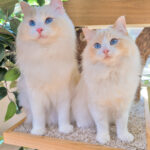Have you ever noticed a cat with adorably crossed eyes? This condition, known medically as strabismus, can be a charming quirk in our feline friends. It’s more than just a cosmetic feature; strabismus in cats is a condition worth understanding, especially if you are a cat owner or considering adopting one.
What is Strabismus in Cats?
Strabismus is the medical term for what is commonly known as “crossed eyes.” In cats, it occurs when their eyes don’t look in exactly the same direction at the same time. One eye might look straight ahead, while the other eye turns inwards, outwards, upwards, or downwards. This misalignment can affect one or both eyes and isn’t exclusive to any particular direction of gaze.
Causes of Cross-Eyedness in Cats
Several factors can contribute to strabismus in cats. One significant cause, particularly in breeds like Siamese, is genetics. It’s believed that some Siamese cats inherited this trait due to selective breeding practices in the past. Other potential causes listed by Petmd include:
- Muscle Imbalance: An imbalance in the tone of the extraocular muscles (muscles outside the eye) can lead to misalignment.
- Restricted Muscle Mobility: Anything that hinders the movement of the muscles around the eye, such as scar tissue from injury or inflammation, can also cause strabismus.
- Neurological Issues: Abnormal crossing of visual fibers in the central nervous system can also be a factor.
Adapting to Strabismus: Kittens vs. Adult Cats
Interestingly, a study explored how cats adapt to strabismus. Kittens who developed strabismus early in life showed a remarkable ability to adjust their vision and maintain their jumping skills. However, adult cats that suddenly developed strabismus found it more challenging to compensate. This suggests that if you are considering adopting a kitten with crossed eyes, especially one with Siamese heritage, they are likely to have adapted well from a young age and shouldn’t face significant issues. For adult cats with unknown onset strabismus, observation is key to assess their adjustment.
When Cross-Eyedness in Cats Needs Veterinary Attention
While genetic strabismus present from birth is often considered a cosmetic issue, a sudden onset of crossed eyes in a cat that previously had normal eyes is a cause for immediate veterinary attention. This could indicate an underlying health problem or injury requiring prompt diagnosis and treatment.
Living with a Cross-Eyed Cat
For cats with congenital strabismus, there’s generally no need for correction. Once they’ve adapted, it’s primarily a cosmetic condition. If you’re considering adopting a cross-eyed cat, especially a Siamese, remember that their unique gaze is just one part of their charm. Focus on providing love, care, and a safe environment, regardless of this visual quirk. Responsible cat ownership is about cherishing each cat’s individuality and ensuring their overall well-being.

